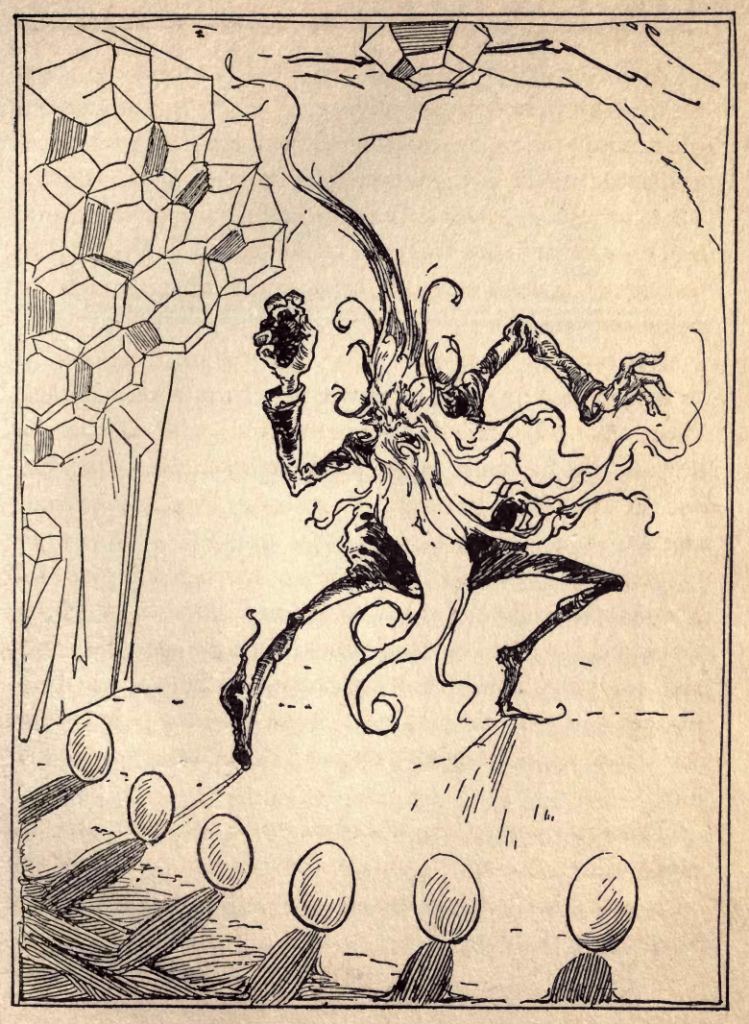
The three “bands of evil spirits” (146) whom the Nome King allies with in The Emerald City represent traits similarly antithetical to Oz’s tolerant egalitarian society. The Chief of the Whimsies acknowledges that Ozma has not wronged his people (62) but agrees to destroy Oz anyway for the promise that the Nome King will enlarge their heads so that they can be more intelligent and appealing (63). The second, the Grand Gallipoot of the Growleywogs and his soldiers, agree to assist the Nomes in exchange for twenty-thousand slaves “and all the gold and jewels we want” and plan to betray and enslave the Nomes as well (82–84). The third, the Phanfasms, agree to assist the Nomes not for material benefit but for “the pleasure of destroying innocent and harmless people” (125). Instead of tolerance, the Growleywogs and the Phanfasms both treat even friendly outsiders with extreme hostility, abducting and torturing Guph although he visits them as an apparently peaceful ambassador. The possibly more sympathetic motive of the Whimsies I will return to later.
The sadism of the Phanfasms is another trait they share with the Nome King, as well as his minion Guph who represents the Under World for most of The Emerald City. Guph’s childlike motive for imperialism is stated plainly: “He hated every one who was good and longed to make all who were happy unhappy” (59). The Nome King shares this sadism, choosing to slowly winnow away Ozma and her army instead of eliminating them all at once because “it is more fun this way” and “serves to keep [him] amused for a long time” (Ozma of Oz 192) and abusing his subjects for the fun of it.
Wanton violence defines the other evil powers as well. The Phanfasms’ method of conquest is “to take all the treasures in Oz” and “to kill all who could be killed and enslave the rest” (Emerald City 275). Except for Jinjur, all villains in the Oz series display a similar disregard for the lives and freedom of others: the Wicked Witch of the West is a slaver who spares no effort to kill Dorothy and her friends, for example, and the Mangaboos and Gargoyles in Dorothy and the Wizard attempt to execute everyone who enters their countries.
Greed is the other core motivator of the evil powers, all of whom aim to steal wealth and take slaves. In addition, the Ozites cooperate out of mutual regard, but the evil powers, more akin to real-life geopolitical actors, ally with each other only for expediency and material gain. The procession of monsters all hate each other, and the Chief of the Whimsies, the Nome King, the Grand Gallipoot, and the First and Foremost of the Phanfasms intend to immediately betray all the others (276–277). Their reasons for doing so are pecuniary in nature. The Chief of the Whimsies plans to wipe out the Nomes, Growleywogs, and Phanfasms, for instance, in order to “keep all the slaves and treasure of Ozma’s kingdom for himself” (276). Even Guph schemes to overthrow the Nome King (86). A lack of love or compassion for even each other is a recurring trait among Oz’s enemies in the series more broadly. Consider also the Nome King and Kiki Aru’s relationship in The Magic of Oz, where each deceives the other in their wrangling over magical power.
Given the cumulative traits of the evil spirits generally and the Nome King in particular, the major villains of the Oz series, as highlighted in The Emerald City, represent a ruthless imperialist, capitalistic, patriarchal, intolerant society, the threat the big, cold outside world poses to the idyllic feminist socialism of Oz. This menace requires Glinda to magically seal Oz away from the rest of the world, as otherwise it would be colonized and destroyed in the way the US, the Nome King, and other powers colonize and destroy those weaker than them.